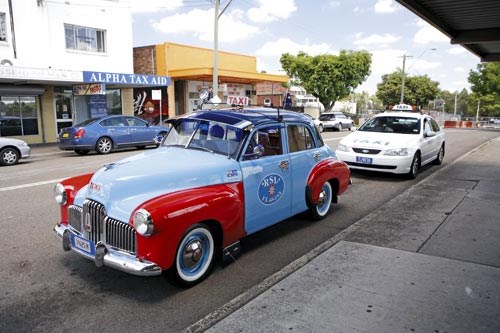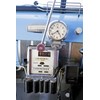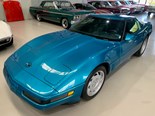1953 Holden 48-215 RSL taxi
 Holden 48-215 taxi
Holden 48-215 taxi



 Holden FJ taxi
Holden FJ taxi

 Holden FJ taxi
Holden FJ taxi


|
|
Holden 48-215 taxi
|

|

|
|
Holden FJ taxi
|

|
|
Holden FJ taxi
|
Check out this fab taxi! Bland modern taxis are no patch on the flashy blue and red Holdens that were once a common sight around Sydney.

|
|
Holden 48-215 taxi
|
Holden taxi
RETURNED SOLDIER
As I stepped into this period taxi, the memories came flooding back. In 1953 my uncle purchased a near new 48-215 ‘FX’ Holden. I was 10-years-old and coming from a family without a car I thought it was the best thing since sliced bread.
Sitting in the rear of Eddy Tabone’s 1953 FX ‘RSL’ taxi, the day before the 60th anniversary of Australia’s first locally developed car, made me realise just how advanced they must have felt when they first hit the streets on November 29, 1948.
The RSL taxi is from the last year of manufacture of the FX before Holden introduced the improved FJ model. But for Eddy Tabone, a dedicated Holden man, the 48-215 holds special memories – he purchased one as his first car in 1960 at the age of 17 and is adamant that his taxi will be the last car he ever owns. But he’s not one-eyed; he’s also owned a 1928 Model A Ford tourer for the last 40 years.
The opportunity to buy his very original FX, came up in 2004, and much to his delight was the fact that the car had originally served as a taxi. In recognition of RSL Ex-Servicemen’s Cabs and their support of ex-servicemen returning from the war, Eddy decided to restore the old taxi in the colours of the 1950s originals. Using the company’s genuine General Motors-Holden colours of Navy Blue, Sky Blue and Red he has recreated a very familiar sight on Sydney roads during the ’50s and ’60s.
RSL Ex-Servicemen’s Cab and Co-Operative Members Ltd was formed in 1946 by two returning servicemen from World War II designed to rehabilitate veterans and by 1948 the company had a number of unrestricted taxi cab plates on issue.
By 1952, with the FX becoming the vehicle of choice for the then eight taxi companies operating in Sydney, GM-H realised there was a need for a special heavy duty 48-215 model and in July of that year released the Holden business sedan for taxi and fleet use.
By 1953 RSL cabs had 60 cars operating in Sydney and had pioneered the use of two-way radio, employing just one telephonist/operator and the help of volunteer labour.
Eddy Tabone’s RSL cab is faithful in every respect, right down to the period taxi meter and the illuminated vacant sign behind the near side sun visor.
The restoration project took six months to complete with the aid of his son Ian, brother-in-law Frank and cousin Vince.
START THE METER
I clamber into the back seat, immediately impressed with the comfort – the position is more upright than today’s model but is a surprisingly pleasant environment. The taxi is accurate down to the small grab handles on the doors and a body-width grab handle behind the front seat.
This passenger aid was quickly dubbed the "Jesus" bar in recognition of the fact there were no seat belts and in an emergency passengers were heard to shout, "Oh Jesus!" It was also renowned for cracking children’s front teeth when they were thrown forward under heavy braking.
The seats and door trims have been refurbished in red leather and, properly bolstered, they provide good lumbar support despite the lack of a seat belt. Interestingly, the lack of seat belts is a good reminder of just how effective they are in preventing injury but of course in 1953 these life saving elements were still a long way from being gazetted as necessary safety devices.
Eddy is a stickler for originality and his pride and joy is correct down to the period reproduction rubber floor mats, the correct headlining, a scuff plate on the bottom of the front seat back so you don’t mark the leather and accessories that most Holden taxis of the period carried, like the rear venetian blind. Remember this was the era before air-conditioning, so it has a real purpose, as do the very effective tinted blue wind deflectors that fit on the bottom of the front quarter lights to direct fresh air on your feet.
Other nice touches are the traditional money bag, in matching red leather, hanging from the steering column, a change dispenser under the taxi meter and two period accessories – anti-theft turn screws for the front quarter light windows and a period clock.
Externally, it’s fitted with kerb scrapers, which are flexible spring mounted wires fixed to the bottom of the guards to warn the driver when he’s too close to the kerb. The car is also graced with a very nice "Auto Sun Shields" external sun visor and a roof bar mounted Delio spot light.
Eddy concedes the white wall tyres are a bit of overkill but a percentage of taxis had them and, given the show nature of this brightly coloured vehicle, they really look the part.
Also on board are period reversing lights, front and rear mud flaps, chrome scuff plates under the door handles, which carry the Holden Lion symbol, rear vision mirror covers and wind deflectors on the front windows.
The business sedans were given a beefed up suspension and shock absorbers and extra fittings like an extra interior light switch on the inside of the nearside B pillar.
The items I recall on my Uncle’s 48-215 are the classy Lion embossed red centre to the steering wheel and the anodized style finish inside the instrument cluster. And of course the three-on-the-tree gear shifter with its black pointed end fitting.
We do a short tour of Sydney’s western suburbs including a visit to the taxi ranks at Wentworthville Railway Station and the reaction to this old, brightly coloured taxi is simply amazing. I’ve driven veteran and vintage cars for over 50 years and, yes, you get the odd wave, horn blown or whistle but this vehicle is a an absolute people magnet – the reaction from the public was a total surprise. Eddy tells me it’s the same at show days where it gets a huge response compared with more standard examples.
Fully restored mechanically, the RSL cab would be in far better condition than many of the taxis running around the streets of Sydney in 1953... and 2009! On the road, it feels extremely tight and has surprisingly good brakes. Fare for all A bridge maintenance engineer with the Roads and Traffic Authority, Eddy keeps his prized possession in top condition and, as a member of the FX and FJ Holden Car Club, takes it long distances for show days. As he says, "Air-conditioning and the lack of seat belts are the only minus." The beloved cab is a nice cruiser on the open road and loses little in modern traffic.
His push for authenticity has gone down to displaying the correct flag fall and mileage cost – the rear window sticker has been faithfully restored at one shilling and three pence flag fall and one shilling and one pence per mile. Sure beats the current Sydney taxi rate of $3.10 flag fall, $2.00 radio booking fee and $1.85 per kilometre!
But the important thing about this colourful car is its timely reminder of how RSL cabs played a significant role in helping to restore a normal life for many of our returned diggers. For many years, this taxi company played an important part in transporting incapacitated and elderly diggers in the annual Anzac Day march.
Maybe that’s why so many older people react so positively to Eddy’s taxi – believe me, by the time our morning stint is over I’m beginning to master the royal wave and have a permanent smile on my face. As a unique car, they don’t come much better.
OLD YELLA
Eddy Tabone’s magnificent 48-215 is not the only classic cab doing the rounds of car shows in Australia.
Back in 2000, Unique Cars featured a stunning, restored 1923 Yellow Cab, believed to be one of only two authentic examples in the country. The then owner, Reg Harris, spent more than 30 years hunting down his, eventually locating it in a paddock in central Victoria, minus its bodywork.
The purpose-built Yellow Cab originated in the US in the early part of last century and utilised a specially designed chassis and variety of engines. Company founder was John Hertz, who later established Hertz Rent-A-Car.
With every one of Melbourne’s 300-strong Yellow Cab fleet scrapped in 1930, and resold to farmers and prospectors with the bodywork removed, Harris resorted to old pictures, parts from other cabs and information from Yellow enthusiasts in the US, to complete the two-year restoration.
SPECIFICATIONS
1953 Holden 48-215 RSL taxi
Body: four-door sedan
Weight: 1011kg
Engine: 2.15-litre in-line six
Transmission: three-speed manual
Power/torque: 45kW/ 135Nm
Top speed: 132km/h
Unique Cars magazine Value Guides
Sell your car for free right here
Get your monthly fix of news, reviews and stories on the greatest cars and minds in the automotive world.
Subscribe

.jpg)









.png)

